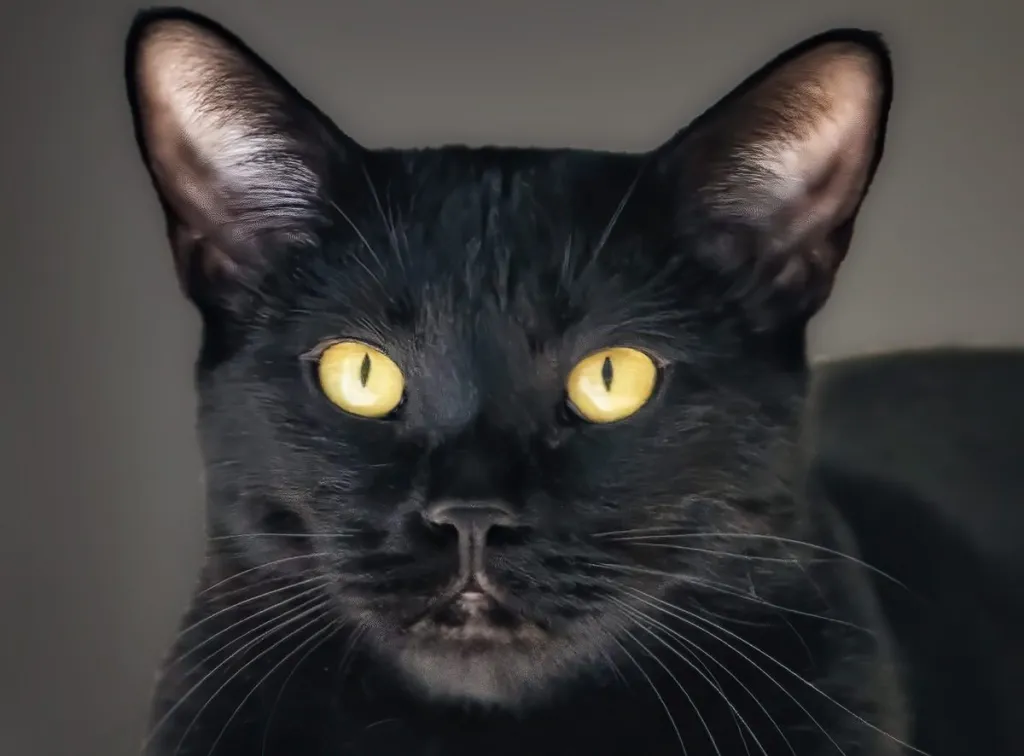Breeders carefully crossed sable Burmese and black American Shorthair cats in the mid-20th century to create the Bombay cat, a breed renowned for its striking appearance and affectionate nature. The vibrant city of Bombay, now Mumbai, India, inspired the name for the Bombay cat.
Furthermore, what sets this breed apart is its sleek, black coat that shines like polished patent leather, accentuating its muscular and compact body. With large, expressive copper or gold eyes, the Bombay’s gaze is both alluring and captivating. Moreover, beyond its exquisite physical traits, this charming cat captivates hearts with its friendly and outgoing personality. These affectionate, social, and intelligent cats forge strong bonds with their human companions.
When considering a Bombay cat, it’s advisable to prioritize adopting from rescue organizations or shelters to provide a loving home to a cat in need. However, if you decide to purchase a Bombay kitten, it’s crucial to choose a reputable breeder. Conduct thorough research to ensure that the breeder follows ethical practices and prioritizes the well-being of their cats. Reputable Bombay breeders prioritize the health and temperament of their cats, conduct necessary health screenings, and provide a nurturing environment for the kitties. This active approach ensures that you bring home a healthy and happy kitty while discouraging unethical breeding practices.
Quick Facts
- Origin: United States
- Size: Medium
- Breed Group: Shorthair
- Lifespan: 9-13 years
- Coat: Short, dense, and jet black, with black nose and paw pads
- Temperament: Intelligent, playful, and affectionate
- Exercise Needs: Moderate
- Training: Easy to train
- Grooming: Weekly brushing
- Health: Generally healthy, but can be prone to certain genetic health conditions, such as hypertrophic cardiomyopathy (HCM)
- These cats were bred to look like a black panthers. They are sometimes called “mini-panthers” or “parlor panthers.”
- Due to their Burmese heritage, sometimes a sable kitten will show up in a litter.
- There are two types of Bombay cats: American and British. The main difference lies in the resulting eye color. While the American Bombay cat stuns with beautiful golden copper eyes, the British Bombay cat sports sharp green eyes.
Bombay Cat Pictures
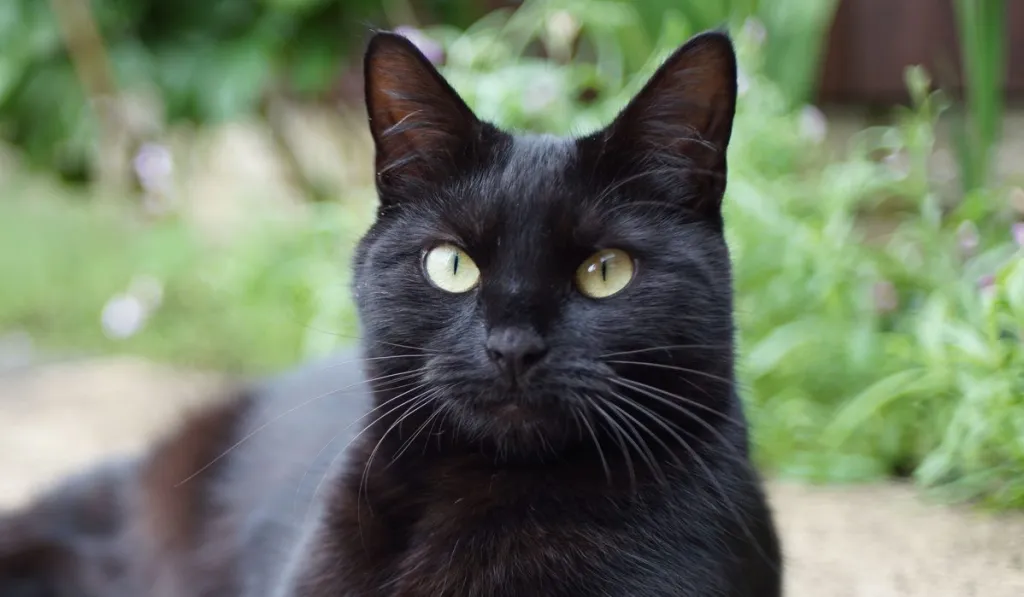
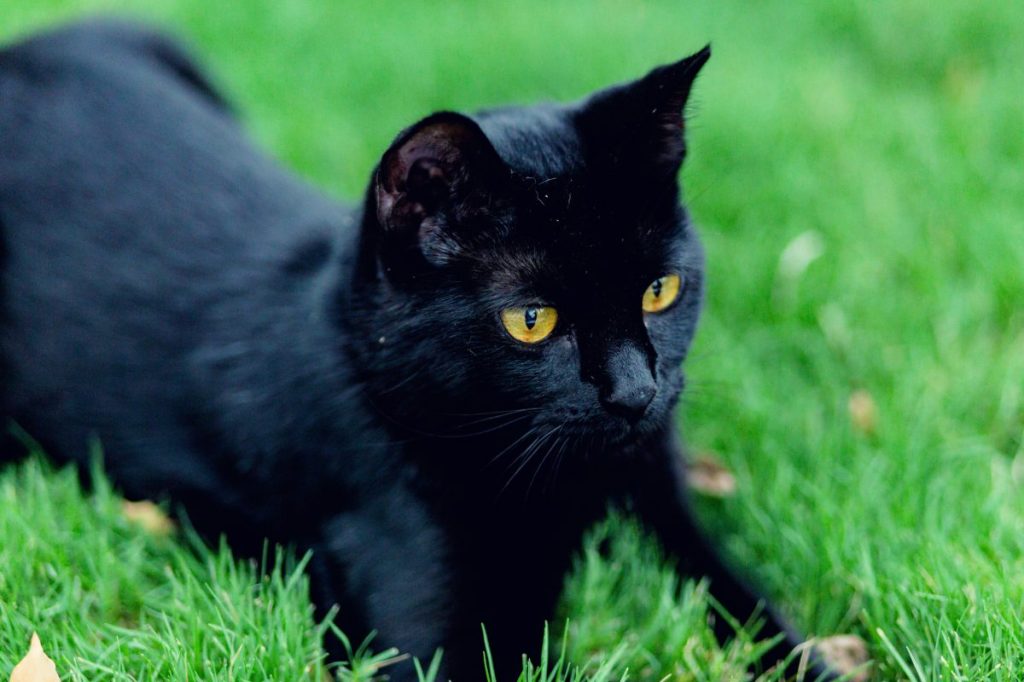
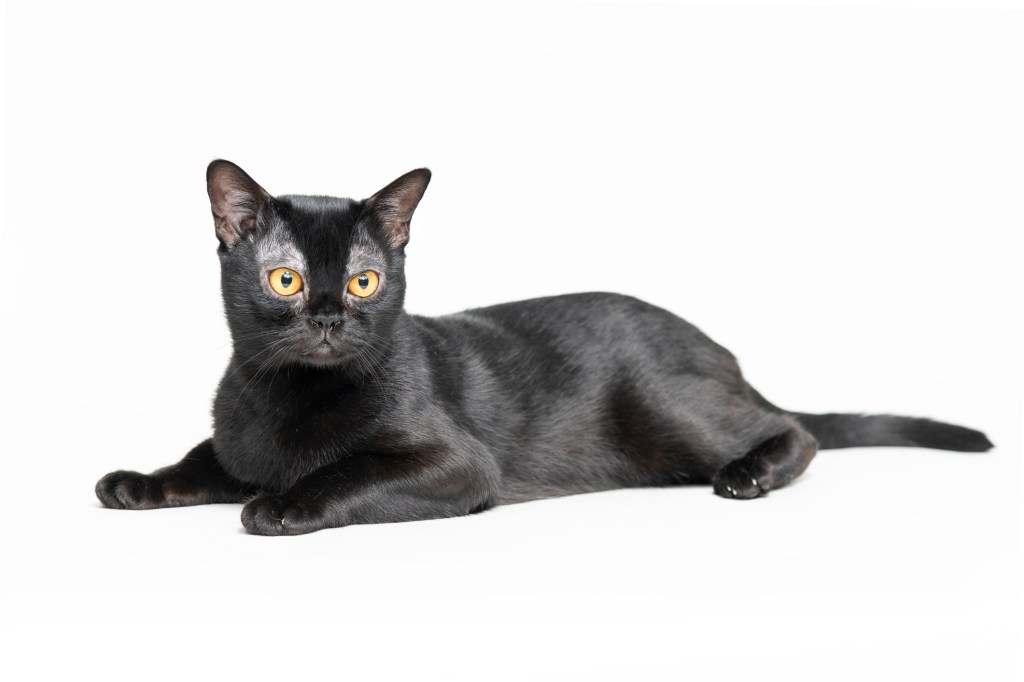
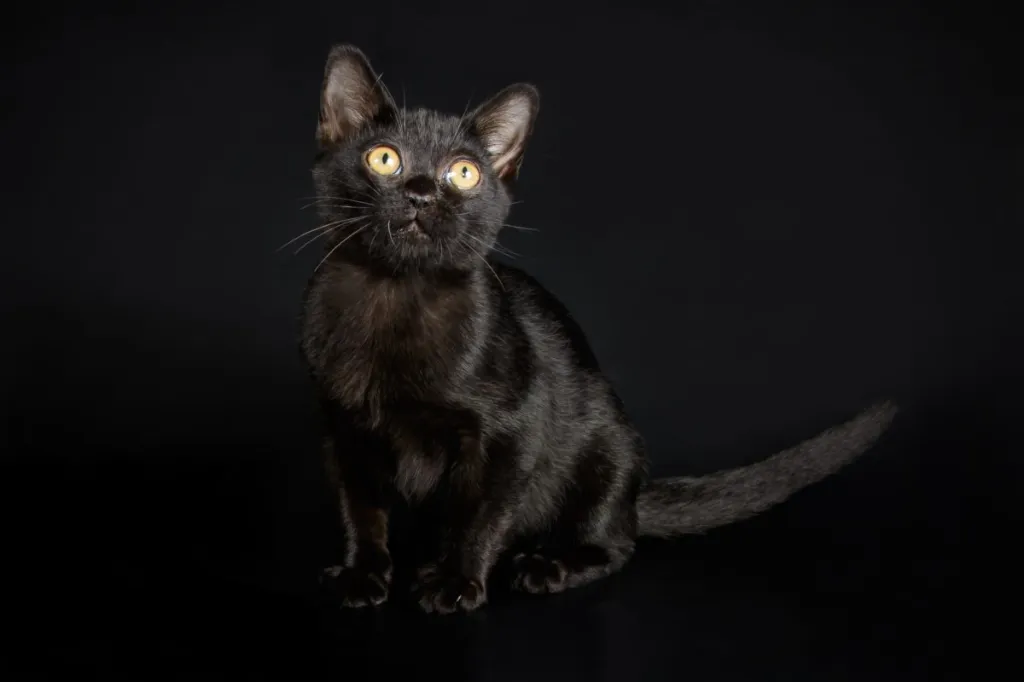
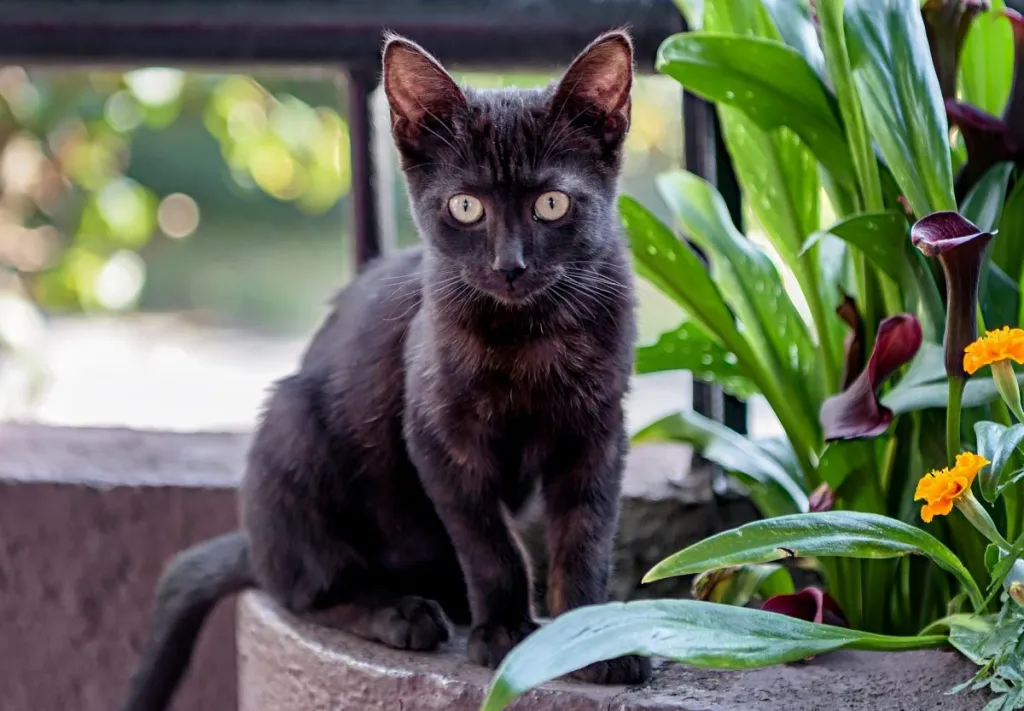
-
Affectionate with Family
Some cat breeds are typically independent and aloof, even if they’ve been raised by the same person since kittenhood; others bond closely to one person and are indifferent to everyone else; and some shower the whole family with affection. Breed isn’t the only factor that goes into affection levels; cats who were raised inside a home with people around feel more comfortable with humans and bond more easily.

See Cats Less Affectionate with Family -
Amount of Shedding
If you’re going to share your home with a cat, you’ll need to deal with some level of cat hair on your clothes and in your house. However, shedding does vary among the breeds. If you’re a neatnik, you’ll need to either pick a low-shedding breed or relax your standards. This furniture cover can make it easier to clean up cat hair and keep it off your sofa!
-
General Health
Due to poor breeding practices, some breeds are prone to certain genetic health problems. This doesn’t mean that every cat of that breed will develop those diseases; it just means that they’re at an increased risk. If you’re looking only for purebred cats or kittens, it’s a good idea to find out which genetic illnesses are common to the breed you’re interested in.
-
Potential for Playfulness
Some cats are perpetual kittens—full of energy and mischief—while others are more serious and sedate. Although a playful kitten sounds endearing, consider how many games of chase the mouse-toy you want to play each day, and whether you have kids or other animals who can stand in as playmates. A classic wand cat toy like this one is perfect for playful felines!
-
Tendency to Vocalize
Some breeds sound off more often than others with meows, yowls, and chattering. When choosing a breed, think about how the cat vocalizes and how often. If constant “conversation” drives you crazy, consider a kitty less likely to chat.
-
Kid-Friendly
Being tolerant of children, sturdy enough to handle the heavy-handed pets and hugs they can dish out, and having a nonchalant attitude toward running, screaming youngsters are all traits that make a kid-friendly cat. Our ratings are generalizations, and they’re not a guarantee of how any breed or individual cat will behave; cats from any breed can be good with children based on their past experiences and personality.
-
Friendly Toward Strangers
Stranger-friendly cats will greet guests with a curious glance or a playful approach; others are shy or indifferent, perhaps even hiding under furniture or skedaddling to another room. However, no matter what the breed, a cat who was exposed to lots of different types, ages, sizes, and shapes of people as a kitten will respond better to strangers as an adult.
-
Easy to Groom
Some breeds require very little in the way of grooming; others require regular brushing to stay clean and healthy. Consider whether you have the time and patience for a cat who needs daily brushing. You should definitely pick up this awesome de-shedding tool for cats of any hair length!
-
Intelligence
Some cat breeds are reputed to be smarter than others. But all cats, if deprived the mental stimulation they need, will make their own busy work. Interactive cat toys are a good way to give a cat a brain workout and keep them out of mischief. This scratcher cat toy can keep your smart kitty busy even when you’re not home!
-
Pet Friendly
Friendliness toward other household animals and friendliness toward humans are two completely different things. Some cats are more likely than others to be accepting of other pets in the home.
Bombay History
Cat breeders are an experimental lot, creating distinctive new breeds either by building on natural genetic mutations or by crossing breeds to achieve a new look, color or pattern. The Bombay, named for the exotic port city of India, has no connection with the subcontinent but was created from crosses between sable Burmese and black American Shorthairs to resemble a black panther in miniature.
Breeder Nikki Horner of Louisville, Kentucky, is credited with developing the Bombay, starting in the late 1950s. Her goal was a sleek, shiny black cat with a muscular body and friendly temperament. British breeders achieved the same look and personality with crosses of Burmese and black domestic shorthairs.
The Cat Fanciers Association gave the Bombay full recognition in 1978. Today the breed is recognized by all cat associations. To maintain their body type and coat texture, Bombays may be outcrossed to sable Burmese. The CFA also permits outcrosses to black American Shorthairs, but this is rarely done because of differences in body type.
Bombay Size
The Bombay typically weighs between 8 and 15 pounds. Males are generally larger than females.
Bombay Personality
The lively and affectionate Bombay loves people and is adaptable to many different environments and lifestyles. His calm nature makes him a good apartment dweller, and he is amenable to life with other pets, although he definitely wants to be top cat.
Expect to find the Bombay hogging the warmest spot in the house. That includes under the covers at bedtime. Most will converse with their people in a distinctive but not loud voice. Bombays are often good at playing fetch, and some have learned to walk on leash. This is a smart cat who loves to play and will thrive with a family who is willing to teach him tricks, play games with him and provide him with plenty of interactive toys.
Bombay Health
Both pedigreed cats and mixed-breed cats have varying incidences of health problems that may be genetic in nature. Bombays are generally healthy, although one of the genetic diseases seen in Burmese has also been seen in Bombays:
- Craniofacial Defect: Sometimes called Burmese head defect, the craniofacial abnormality is occasionally seen in newborn kittens, which may have severely deformed heads. While kittens with this condition are euthanized, it’s always worth researching breeders pedigrees carefully to make sure they don’t breed cats who carry the gene for the defect.
Bombay Care
The Bombay’s short, sleek coat is easily cared for with a few strokes of the hand or at most weekly brushing or rubdown with a chamois to remove dead hair, distribute skin oil and polish the coat to its gleaming best. A bath is rarely necessary.
Brush the teeth to prevent periodontal disease. Daily dental hygiene is best, but weekly brushing is better than nothing. Wipe the corners of the eyes with a soft, damp cloth to remove any discharge. Use a separate area of the cloth for each eye so you don’t run the risk of spreading any infection.
Check the ears weekly. If they look dirty, wipe them out with a cotton ball or soft damp cloth moistened with a 50-50 mixture of cider vinegar and warm water. Avoid using cotton swabs, which can damage the interior of the ear.
Keep the litter box spotlessly clean. Like all cats, Bombays are very particular about bathroom hygiene. Plan to spay or neuter your Bombay at 6 to 9 months of age. It is not unheard of for Bombays to reach sexual maturity as early as 5 months of age.
It’s a good idea to keep a Bombay as an indoor-only cat to protect him from diseases spread by other cats, attacks by dogs or coyotes, and the other dangers that face cats who go outdoors, such as being hit by a car. Bombays who go outdoors also run the risk of being stolen by someone who would like to have such a beautiful cat without paying for it.
Bombay Coat Color And Grooming
Except for his dramatic black coat, the Bombay looks much like the Burmese, but with a few physical differences such as a larger, longer body and longer legs. He has a rounded head with medium-size ears set wide apart, eyes that range in color from gold to copper, and a straight, medium-length tail. The short, fine coat feels satiny to the touch and shines like patent leather.
Although the gene for the black coat is dominant, a sable-colored kitten is sometimes born in a Bombay litter. Some associations permit these kittens to be registered as Burmese.
The Bombay is a medium-size cat; when lifted, he feels heftier than he looks. The breed develops slowly and males may not reach full size and musculature until they are 2 years old.
Children And Other Pets
The outgoing Bombay is a perfect choice for families with children and cat-friendly dogs. He loves the attention he receives from children who treat him politely and with respect. He lives peacefully with cats and dogs who respect his authority. Always introduce pets slowly and in controlled circumstances to ensure that they learn to get along together.
Bombay Rescue Groups
More Info For You
If you’re also looking for a dog, check out DogTime’s dog breed page!
